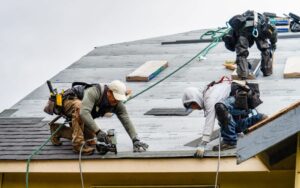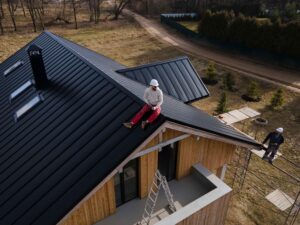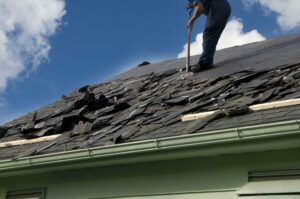Homeowners insurance can cover roof repairs, but it really depends on your policy and the damage’s cause. Typical coverage includes storm damage, like hail or wind, but wear and tear from age is usually excluded. Additionally, your roof’s age and the policy limits can affect your coverage. To guarantee you understand what’s covered, review your policy details. If you want to learn more about maximizing your claim, there’s helpful information ahead.
Understanding Homeowners Insurance Policies
When you’re looking to understand homeowners insurance policies, it is essential to recognize that not all plans offer the same coverage. You’ll need to carefully review policy exclusions, as these can greatly affect your protection. For instance, many policies exclude damages caused by neglect, wear and tear, or certain natural disasters. Additionally, be aware of coverage limits, which determine the maximum amount your insurer will pay for a claim. If your roof sustains damage, knowing these limits can help you gauge whether you’ll receive adequate compensation for repairs. Always read your policy thoroughly and consult with your insurance agent to clarify any uncertainties. This proactive approach guarantees you’re fully informed about what your homeowners insurance covers and what it doesn’t.
Common Causes of Roof Damage Covered by Insurance
Understanding the nuances of homeowners insurance can reveal which specific types of roof damage are typically covered. Generally, storm damage, such as hail or wind-related incidents, is often included in standard policies. If a severe storm causes shingles to lift or your roof to leak, you’ll likely find coverage for those repairs. Conversely, wear and tear due to age or lack of maintenance isn’t usually covered. Insurance companies view these issues as the homeowner’s responsibility, as they result from neglect rather than unexpected events. It is crucial to review your policy carefully, as coverage can vary by provider. Knowing what’s covered can help you prepare for potential claims and guarantee you’re not left with unexpected repair costs.
Factors Affecting Roof Repair Coverage
Several factors can markedly influence your roof repair coverage under homeowners insurance. One significant aspect is the age of your roof. Insurers often have specific guidelines regarding how long roofs remain covered; older roofs may face reduced or no coverage, especially if they show signs of wear. Additionally, your policy limits play an essential role in determining the extent of coverage for repairs. If your policy has lower limits, you might find yourself responsible for a larger portion of the repair costs, particularly for extensive damage. Understanding these factors can help you make informed decisions about your insurance and guarantee you’re financially prepared for potential roof repairs. Always review your policy for specific conditions related to roof coverage.
The Claims Process for Roof Repairs
Maneuvering the claims process for roof repairs can be complex, especially if you’re unaware of the specific steps required by your insurance provider. First, you’ll need to gather all necessary claims documentation, including photos of the damage and any relevant receipts. Next, obtain repair estimates from licensed contractors, as your insurer will likely require these to assess the claim accurately. After compiling the documentation and estimates, submit your claim to your insurance company. Be prepared for an adjuster’s visit to inspect the damage firsthand. Throughout the process, maintain clear communication with your insurer to guarantee all required information is provided. Staying organized can help streamline the process and increase your chances of a successful claim outcome.
Tips for Maximizing Your Insurance Claim
To guarantee you get the most from your insurance claim, it’s crucial to approach the process strategically. Start by gathering thorough claim documentation, including photos of damage and repair estimates. This evidence supports your case and can expedite approval. Familiarize yourself with your policy limits, as knowing what’s covered helps you avoid surprises down the line. Be proactive in communicating with your insurer; respond promptly to requests for additional information. If necessary, consider consulting a public adjuster to confirm your claim is maximized. Finally, keep meticulous records of all interactions related to your claim, as this can prove invaluable if disputes arise. Following these tips can greatly enhance your potential payout for roof repairs.
Will Homeowners Insurance Pay for Roof Repair?
replacement cost
insurers
asphalt shingles
insured
insurer
cost
will homeowners insurance pay for roof repair?
roof insurance claim
roof repair
roof replacement claim
roof repairs
quick roof repairs
homeowners insurance policies
roof replacement contractors
roof claim
roof coverage
roof replacement specialists
roof replacements
roof damage
roofing contractor
roof replacement
local roofing company
roof needs
free roof inspections
local roofing inspection
roof inspection
new roof replacement
local roofers
roofing
insurance pay
local roofing companies
reputable roofing contractor
full roof replacement
old roof
repair costs
roofing companies
home insurance policy
insurance pays
out-of-town roofers
roof investment
free roof
reputable roofing company
roofing industry
new roof
cheap roof equals
homeowner
repair coverage
repair estimates
vulnerable homeowners
insurance adjuster finds
insurance money
will pay
insurance estimate
money insurance
insurance coverage
many homeowners
insurance doesn
insurance claim process
repairs
quick repairs
architectural asphalt shingles
3-tab asphalt shingles
insurance process
replacement cost value
repair
pay
inadequate repairs
payout
damage
home
cost value
cost
inspection report
claim





